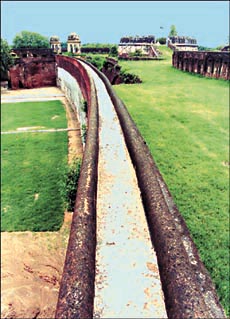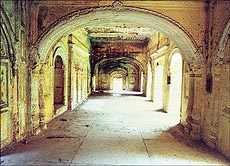







|
The ancient Bahadurgarh Fort discouraged invaders due to its unique impregnable architecture. Today, it is unable to even withstand the onslaught of the elements, says Jupinderjit Singh
A crumbling citadel
 WHEN Nawab Saif Khan laid the foundation stone of a kuchi garhi (mud fort) in 1658 AD at his native village, Saifabad, now popular as Bahadurgarh, near Patiala, he may have never imagined that the small fort would earn the distinction of ‘an impregnable citadel’ and would also be revered for all times to come for its association with Guru Tegh Bahadur, the ninth Sikh Guru. It is said that the Guru stayed for nearly two months at this fort before he went to Delhi and attained martyrdom at the hands of Aurangzeb. WHEN Nawab Saif Khan laid the foundation stone of a kuchi garhi (mud fort) in 1658 AD at his native village, Saifabad, now popular as Bahadurgarh, near Patiala, he may have never imagined that the small fort would earn the distinction of ‘an impregnable citadel’ and would also be revered for all times to come for its association with Guru Tegh Bahadur, the ninth Sikh Guru. It is said that the Guru stayed for nearly two months at this fort before he went to Delhi and attained martyrdom at the hands of Aurangzeb.
However, this 340-year-old fort, which was made pucca by Nawab’s descendant Maharaja Karam Singh, is in a dilapidated condition today.
Nawab Saif-ud-Din Mah-mud, popularly known as Faqirullah, was a foster brother of Aurangzeb. After his retirement as the subedar of Kashmir, he came to his village, Saifabad, and settled there.
The date of the foundation of the fort can be deduced by an inscription found on an inner gate of the fort. The Persian chronographic inscription has been composed by well-known poet Sheikh Nasir Ali of Sirhind.
According to "abjad calculation" of the inscription, the date of foundation of the fort comes to 1658 AD.
Saif Khan, a pious Muslim, also constructed a mosque in the fort in 1668. The date is again calculated from an inscription found on a marble stone on one of the walls of the mosque. This mosque is today known as Saif Khan’s Mosque.
The fort was held by the descendants of Saif Khan up to the reign of Maharaja Amar Singh (1765-82) when it was annexed to the Patiala state. Chhota Rasulpur village was given to the remaining descendants of Saif Khan with a life pension of Rs 7 a day to Gul Begh Khan, the last commandant of the fort. This jagir remained till 1947 when the recipients migrated to Pakistan.
The fort was made pucca in 1845 by Maharaja Karam Singh, a descendant of Maharaja Amar Singh. It was Maharaja Karam Singh who gave the fort the present name of Bahadurgarh, in memory of Guru Tegh Bahadur who had paid a visit to the place during the time of Saif Khan.
The ancient citadel that discouraged many invaders due to its unique impregnable architecture is today unable to withstand the weathering.
It was called impregnable as three huge walls and two broad and deep moats full of crocodiles had to be crossed to penetrate into the fort. The strong structure has given way due to the vagaries of nature as few hands have came forward to save the ancient fort.
The circumference of the fort is 1 mile, 536 yards and 2 feet. It is an oval-shaped structure. It was once surrounded by two huge and broad circular walls. The 29-foot high outer wall was 110 feet away from the inner one. In between, there was a ditch full of crocodiles. The outer wall was surrounded by another moat 25 feet deep and 58 feet wide. There was a similar moat separating the inner wall from the third one.
 As it was impossible for invaders to cross these walls and crocodile-filled moats, the only other method to penetrate the fort was through its main entrance. As it was impossible for invaders to cross these walls and crocodile-filled moats, the only other method to penetrate the fort was through its main entrance.
This route taken by many was found to be extremely difficult. The meandering path that led from the entrance to the inner palace obstructed any speedy penetration by the invading army. These invaders were also subjected to firing when they were on the path through the holes in the walls. Any attempt to break the gates was successfully foiled by the defenders who poured boiling oil on the elephants or soldiers through specially designed holes in the roof tops of these gates.
Today, the outer wall has collapsed at many places. The moats have got filled up with sand and wild vegetation. At many places, the wild vegetation has been cleared by villagers living nearby, who have encroached upon the land to cultivate it. Cracks have appeared on the inner walls too, as weeds and shrubs have sprouted on the walls. The third floor of the residential complex in the fort has fallen apart completely, while the second floor has given way at a number of places. Trees, wild shrubs and grass growing in the fort have speeded up the deterioration of the fort. Even the wood carvings on the doors and windows along with paintings, murals and designs on the walls have been destroyed with years of neglect.
The most distressing factor has been the collapse of the water channel bridge whose construction was an amazing engineering feat. It supplied water to all parts of the forts through a specially designed water channel on the roof tops of the buildings of the fort. Water, drawn from a well with the help of two elephants, flowed into these channels. Besides supplying water for drinking, the channel also operated fountains, especially those on the side walls of the queen’s bathing place. This room, made of marble, was recently cleaned up by the commando battalions. It was discovered that the water, through the numerous mouths of the pipe in all four walls, fell in the inner sarovar where the queens or other royal women bathed.
The water passing through the channel also cooled the inner palace rooms by conditioning the air passing through it.
Today, the water supply system and air conditioning system is not in working condition as the well from which the water was drawn has gone dry and is filled up with rubble and garbage. Further, the bridge connecting the water channel and the fort buildings has fallen. Even the sides of the channel in which the water was carried have broken, and at some places the channel has completely disappeared.
A number of tunnels were also present in the fort. It is believed that these tunnels were dug up to the Qila Mubarak in Patiala to save rulers whenever Quila Mubarak was attacked. Various pathways, suggesting a tunnel, can still be seen in the fort. They have been blocked by the rubble.
 Even the two inscriptions, one on the inner gate and the other on the mosque, that inform about the founding of the fort as well as of the mosque can be read today with great difficulty. The ancient mosque, constructed in 1668 by Nawab Saif Khan, is in a pathetic condition too. The rear walls of the mosque had collapsed some years ago. Today, Punjab Police commando battalions that have a permanent residence in the fort have carried out repairs in the mosque. Though this repair work has saved the mosque from crumbling further, due to the absence of professional expertise in renovating ancient buildings, the mosque has lost its original grandeur and sheen. Even the two inscriptions, one on the inner gate and the other on the mosque, that inform about the founding of the fort as well as of the mosque can be read today with great difficulty. The ancient mosque, constructed in 1668 by Nawab Saif Khan, is in a pathetic condition too. The rear walls of the mosque had collapsed some years ago. Today, Punjab Police commando battalions that have a permanent residence in the fort have carried out repairs in the mosque. Though this repair work has saved the mosque from crumbling further, due to the absence of professional expertise in renovating ancient buildings, the mosque has lost its original grandeur and sheen.
G.S. Dhillon, commandant and in charge of the fort, says: "We have done whatever we could do. The material with which the mosque was made could not be found. No professional experts of the Department of Conservation came forward all these years to save the mosque. So under such circumstances the repair work done by the commandos is commendable".
In fact, the commando battalions inside the fort have done their bit to save the fort from further deterioration. They have cleared many pools and fountains of wild vegetation and rubble. Even the trees that grow through the fort walls are cleared from time to time.
But even this continuous clearing has not provided the desired results. The trees and shrubs manage to find a way of sprouting from one place or another. It is not possible to keep an eye on everything, said Dhillon.
The condition of the fort further worsened in 1984, when it was used as a temporary jail during the then jail bharo andolan of the Akalis. Various terrorists were also kept in custody in this fort.
Apart from its rich architecture, the fort has got a religious significance as well. Nawab Saif Khan was a great admirer of Guru Tegh Bahadur. The Guru is said have visited Saifabad at the invitation of the Nawab. Two gurdwaras were built to commemorate the visit of the Guru to the fort. One gurdwara is in the fort and the other in the garden (then called Panch Bati Garden) to the north of the fort.
It is also believed that Saif Khan mediated between the Guru and Aurangzeb over the issue of Kashmiri Pandits. The Nawab knew about the problems faced by Pandits as he had remained subedar of Kashmir for a considerable time. He reportedly held various talks with Aurangzeb and tried to dissuade him from fighting with the Sikh Guru.
It is a pity that nothing is being done today to save this historic structure from going to ruin.
key word : citadel, fort, impregnable citadel
 |


No comments:
Post a Comment